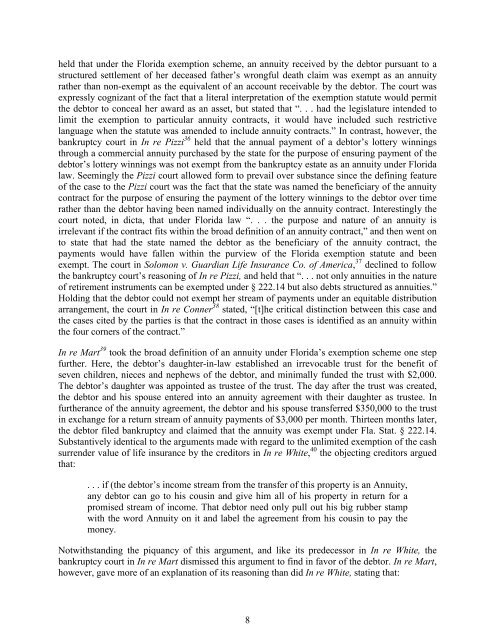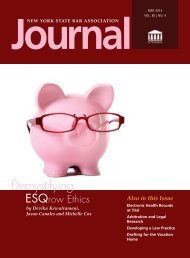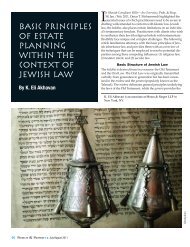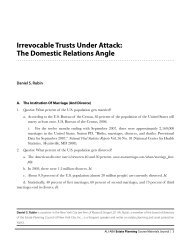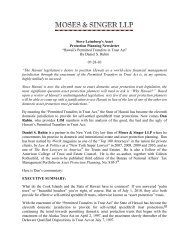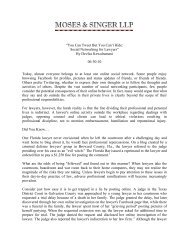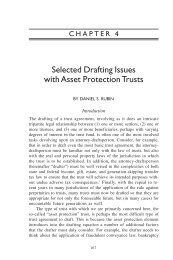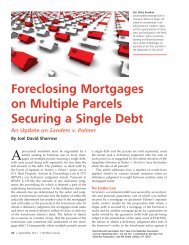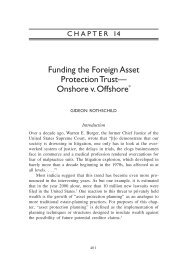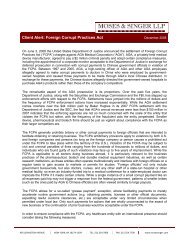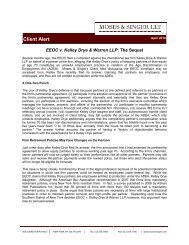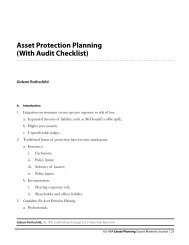Creditor Protection for Life Insurance and Annuities
Creditor Protection for Life Insurance and Annuities
Creditor Protection for Life Insurance and Annuities
You also want an ePaper? Increase the reach of your titles
YUMPU automatically turns print PDFs into web optimized ePapers that Google loves.
held that under the Florida exemption scheme, an annuity received by the debtor pursuant to a<br />
structured settlement of her deceased father’s wrongful death claim was exempt as an annuity<br />
rather than non-exempt as the equivalent of an account receivable by the debtor. The court was<br />
expressly cognizant of the fact that a literal interpretation of the exemption statute would permit<br />
the debtor to conceal her award as an asset, but stated that “. . . had the legislature intended to<br />
limit the exemption to particular annuity contracts, it would have included such restrictive<br />
language when the statute was amended to include annuity contracts.” In contrast, however, the<br />
bankruptcy court in In re Pizzi 36 held that the annual payment of a debtor’s lottery winnings<br />
through a commercial annuity purchased by the state <strong>for</strong> the purpose of ensuring payment of the<br />
debtor’s lottery winnings was not exempt from the bankruptcy estate as an annuity under Florida<br />
law. Seemingly the Pizzi court allowed <strong>for</strong>m to prevail over substance since the defining feature<br />
of the case to the Pizzi court was the fact that the state was named the beneficiary of the annuity<br />
contract <strong>for</strong> the purpose of ensuring the payment of the lottery winnings to the debtor over time<br />
rather than the debtor having been named individually on the annuity contract. Interestingly the<br />
court noted, in dicta, that under Florida law “. . . the purpose <strong>and</strong> nature of an annuity is<br />
irrelevant if the contract fits within the broad definition of an annuity contract,” <strong>and</strong> then went on<br />
to state that had the state named the debtor as the beneficiary of the annuity contract, the<br />
payments would have fallen within the purview of the Florida exemption statute <strong>and</strong> been<br />
exempt. The court in Solomon v. Guardian <strong>Life</strong> <strong>Insurance</strong> Co. of America, 37 declined to follow<br />
the bankruptcy court’s reasoning of In re Pizzi, <strong>and</strong> held that “. . . not only annuities in the nature<br />
of retirement instruments can be exempted under § 222.14 but also debts structured as annuities.”<br />
Holding that the debtor could not exempt her stream of payments under an equitable distribution<br />
arrangement, the court in In re Conner 38 stated, “[t]he critical distinction between this case <strong>and</strong><br />
the cases cited by the parties is that the contract in those cases is identified as an annuity within<br />
the four corners of the contract.”<br />
In re Mart 39 took the broad definition of an annuity under Florida’s exemption scheme one step<br />
further. Here, the debtor’s daughter-in-law established an irrevocable trust <strong>for</strong> the benefit of<br />
seven children, nieces <strong>and</strong> nephews of the debtor, <strong>and</strong> minimally funded the trust with $2,000.<br />
The debtor’s daughter was appointed as trustee of the trust. The day after the trust was created,<br />
the debtor <strong>and</strong> his spouse entered into an annuity agreement with their daughter as trustee. In<br />
furtherance of the annuity agreement, the debtor <strong>and</strong> his spouse transferred $350,000 to the trust<br />
in exchange <strong>for</strong> a return stream of annuity payments of $3,000 per month. Thirteen months later,<br />
the debtor filed bankruptcy <strong>and</strong> claimed that the annuity was exempt under Fla. Stat. § 222.14.<br />
Substantively identical to the arguments made with regard to the unlimited exemption of the cash<br />
surrender value of life insurance by the creditors in In re White, 40 the objecting creditors argued<br />
that:<br />
. . . if (the debtor’s income stream from the transfer of this property is an Annuity,<br />
any debtor can go to his cousin <strong>and</strong> give him all of his property in return <strong>for</strong> a<br />
promised stream of income. That debtor need only pull out his big rubber stamp<br />
with the word Annuity on it <strong>and</strong> label the agreement from his cousin to pay the<br />
money.<br />
Notwithst<strong>and</strong>ing the piquancy of this argument, <strong>and</strong> like its predecessor in In re White, the<br />
bankruptcy court in In re Mart dismissed this argument to find in favor of the debtor. In re Mart,<br />
however, gave more of an explanation of its reasoning than did In re White, stating that:<br />
8


